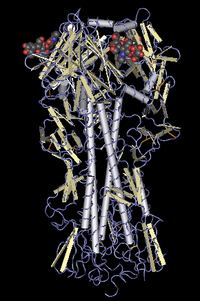Hemagglutinin (influenza)
From Wikipedia, the free encyclopedia

Hemagglutinin is a spike-shaped virus surface protein made of two chain types. Blue: subunit for binding of specific human cell surfaces sugars. Orange: subunit for triggering response (PDB code: 1ruz). (more details...)
Influenza hemagglutinin (HA) or haemagglutinin (British English) is a type of hemagglutinin found on the surface of the influenza viruses. It is an antigenic glycoprotein. It is responsible for binding the virus to the cell that is being infected.
The name "hemagglutinin" comes from the protein's ability to cause red blood cells (erythrocytes) to clump together ("agglutinate") in vitro [1].






No comments:
Post a Comment